Breast Cancer Warning Signs to Recognize
Breast cancer is one of the most common cancers affecting the mammary glands, a key part of the human reproductive system. According to the World Health Organization, over 2.3 million people worldwide were diagnosed with breast cancer in 2020. Early detection is crucial, as many cases are identified at a late stage, which can affect outcomes and survival rates. Recognizing warning signs promptly can greatly improve the chances of successful treatment and increase awareness about this significant health concern.
1. Lump in the Breast

One of the most common and recognizable warning signs of breast cancer is the presence of a lump in the breast. A lump forms when abnormal cells grow and accumulate, often creating a mass or thickened area within the breast tissue. While most lumps are benign (non-cancerous), certain characteristics—such as being painless, hard, and having irregular edges—can be more concerning for malignancy. However, cancerous lumps can also be soft, tender, or rounded, so any new or unusual mass should be taken seriously.
For example, someone performing a self-exam may feel a small, pea-sized nodule or a firm, immovable area that stands out from the surrounding tissue. Lumps can also be discovered incidentally during routine activities such as showering or dressing. It’s important to note that normal breast tissue can feel lumpy or nodular, especially around menstruation, but persistent or new lumps should not be ignored.
If you discover a lump or notice any significant changes in your breast, promptly consult a healthcare provider for evaluation. Early assessment with clinical exams and imaging, such as mammography, can help determine if further testing is needed. For more information, visit the American Cancer Society.
2. Thickening of Breast Tissue
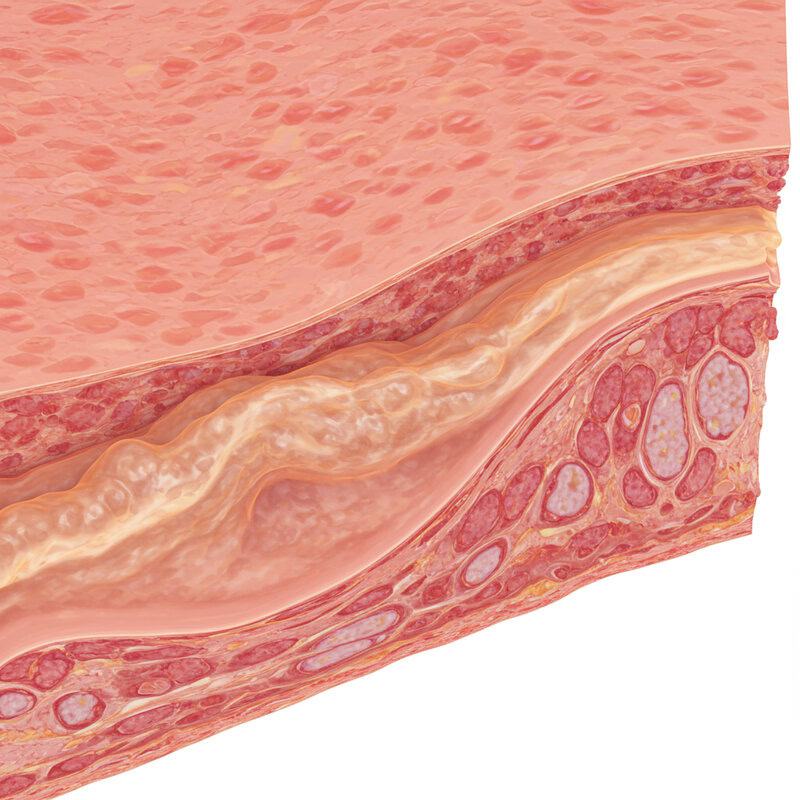
Another important warning sign of breast cancer is the thickening of breast tissue. Unlike a distinct lump, thickening refers to an area of the breast that feels denser or firmer than the surrounding tissue. This change may develop gradually and can be more difficult to detect, especially for individuals who have naturally dense breasts. The underlying cause is often the accumulation of abnormal cells, which can disrupt the normal, soft, and pliable texture of healthy breast tissue.
Normal breast tissue can feel somewhat uneven or grainy, especially during hormonal changes such as menstruation. However, cancer-related thickening is usually persistent and does not fluctuate with the menstrual cycle. It may feel like a firm ridge or an area that stands out compared to the rest of the breast. Sometimes, the thickened area is not painful, making it easy to overlook.
It is crucial to be familiar with the normal look and feel of your breasts through regular self-exams. If you notice any persistent thickening or a change in the texture of your breast tissue, it is recommended to consult a healthcare provider for professional evaluation. For further guidance, visit the Breastcancer.org.
3. Change in Breast Size or Shape
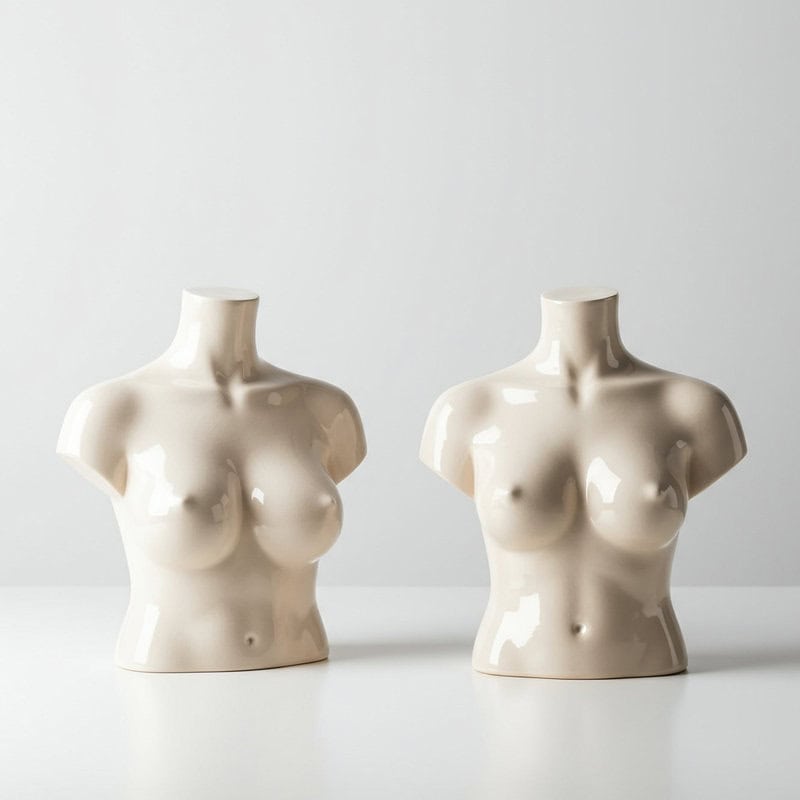
A noticeable change in the size or shape of the breast can be a significant warning sign of breast cancer. Tumors or abnormal growths can disrupt the normal architecture of breast tissue, sometimes causing swelling, distortion, or asymmetry. Unlike natural fluctuations related to hormonal cycles, cancer-related changes are often persistent and may occur in one breast only.
For example, someone may observe that one breast appears noticeably larger, fuller, or has a different contour than the other. This change might become apparent when wearing a bra, noticing a gap or tightness where there wasn’t one before, or when looking in the mirror. In other cases, a previously round breast may develop a sudden irregularity in its outline, or the nipple may appear to be pulled inward, further suggesting an underlying abnormality.
Because subtle shifts in breast size or shape can be easy to miss, it is helpful to regularly observe your breasts in good lighting and to compare both sides for symmetry. Documenting any changes over time can assist your healthcare provider in assessing your risk and determining the need for further imaging. For more information, visit the National Breast Cancer Foundation.
4. Dimpling of the Skin

Skin dimpling, medically referred to as peau d’orange (French for “orange peel”), is a significant warning sign that can indicate the presence of breast cancer. This change occurs when a tumor pulls on the ligaments or lymphatic vessels in the breast, causing the overlying skin to pucker or develop small indentations. The biological basis for this phenomenon lies in the obstruction of lymphatic drainage by cancer cells, which leads to localized swelling and tethering of the skin.
Visually, skin with dimpling often resembles the textured surface of an orange peel—tiny pits or indentations can be seen and felt on the affected area. This change may occur anywhere on the breast, but is often most noticeable when the arm is raised or the breast tissue is compressed. Skin dimpling is not always accompanied by pain but should never be ignored, especially if it develops suddenly or is confined to one area of the breast.
If you notice any sign of skin puckering, dimpling, or texture changes that do not resolve, it is important to seek a professional evaluation as soon as possible. For detailed information and visual references, visit American Cancer Society: Breast Cancer Signs and Symptoms.
5. Redness or Rash
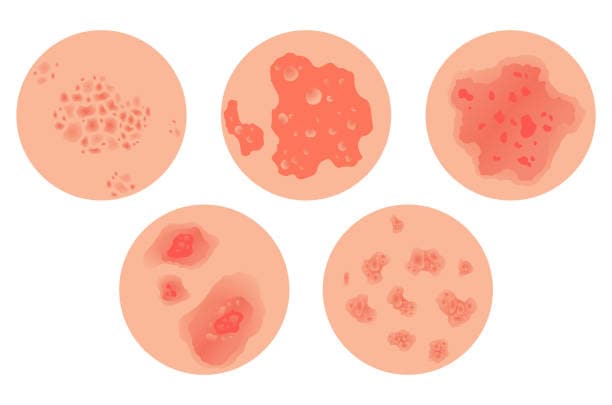
Redness or rash on the breast can be a sign of underlying inflammation, which sometimes indicates a rare but aggressive form of breast cancer known as inflammatory breast cancer. In this condition, cancer cells block lymph vessels in the skin, leading to warmth, swelling, and a reddish appearance. The skin may appear bruised, feel tender, or develop a rash that spreads across the breast. Unlike common skin irritations, these symptoms often do not resolve with topical treatments and may progress rapidly.
It is important to distinguish between benign rashes, such as those caused by allergic reactions, eczema, or heat, and those associated with breast cancer. Benign conditions usually improve with over-the-counter remedies, are often itchy, and may affect both breasts or other areas of the body. In contrast, cancer-related redness or rash is typically persistent, affects only one breast, and may be accompanied by swelling, pain, or skin texture changes.
If you notice unexplained redness, swelling, or a rash that does not improve within a few days or is associated with other changes in your breast, seek prompt medical evaluation. Learn more about inflammatory breast cancer symptoms at the National Cancer Institute.
6. Nipple Discharge (Other Than Milk)
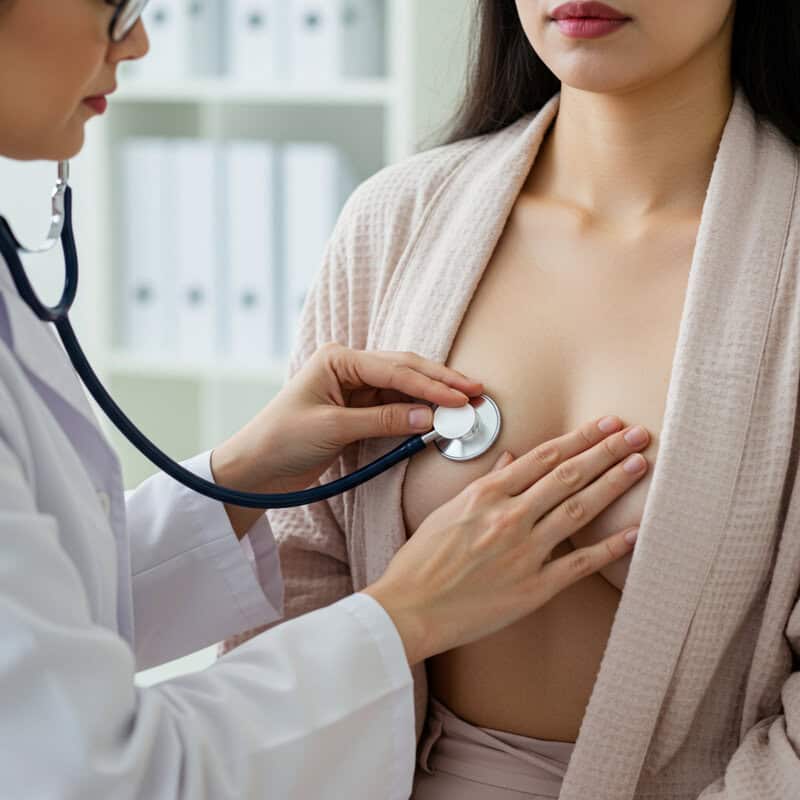
Unusual nipple discharge that is not related to breastfeeding can be an important warning sign of breast cancer. While there are many non-cancerous reasons for nipple discharge, such as hormonal changes or benign growths, discharge that is spontaneous, persistent, or occurs from only one breast warrants further investigation. Cancer-related discharge may be clear, bloody, or have a watery or sticky consistency, and often emerges without squeezing the nipple.
For example, a person might notice a stain on their bra or find fluid seeping from the nipple without any apparent reason. A particularly concerning sign is bloody discharge, which can be associated with underlying malignancy. However, even green, yellow, or pus-like fluids should not be ignored, especially if accompanied by other symptoms such as a lump or skin changes.
It’s important to pay attention to the color, consistency, and frequency of any nipple discharge, as well as whether it occurs from one or both breasts. If you experience any unusual discharge, especially if it is persistent or bloody, consult a healthcare provider for evaluation and diagnostic testing. For more detailed information, visit the Mayo Clinic.
7. Nipple Retraction or Inversion
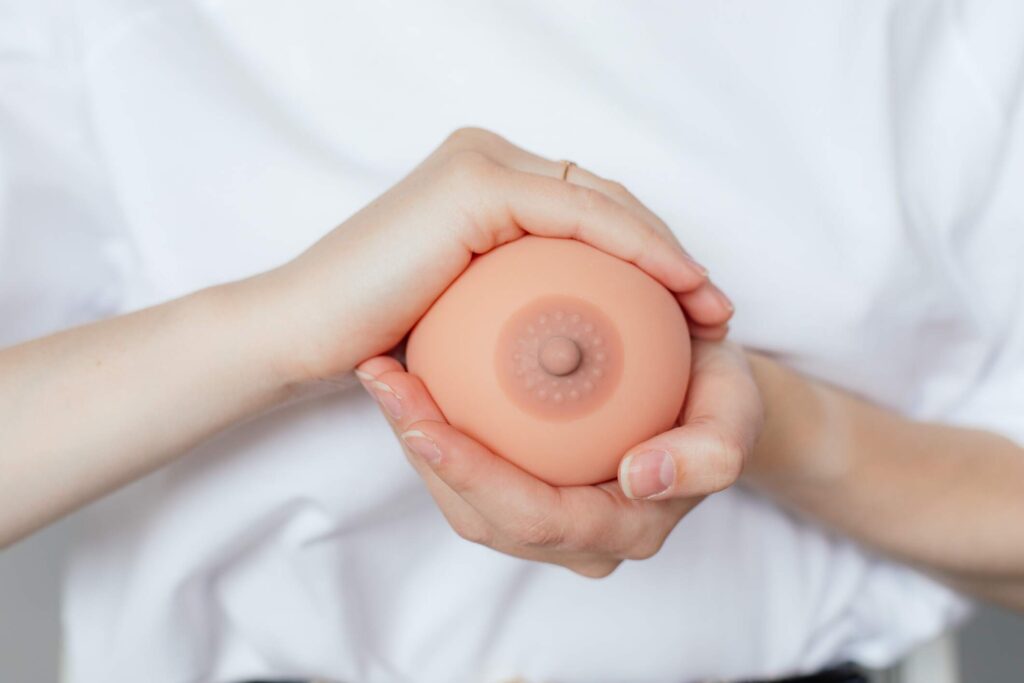
Nipple retraction or inversion is a notable change where the nipple, which normally points outward, becomes pulled inward or appears flattened. This can occur when a tumor or abnormal tissue growth beneath the nipple pulls on the ducts or ligaments, causing the nipple to retract. While some people are born with naturally inverted nipples, this is typically a lifelong characteristic and not usually a cause for concern.
The difference between congenital (lifelong) inversion and a new onset of retraction is crucial. If your nipples have always been inverted, it is generally considered normal. However, if you notice that one or both nipples have become newly inverted or retracted—especially if this change develops suddenly or is accompanied by other symptoms such as a lump, dimpling, or discharge—this can be a sign of an underlying breast abnormality, including cancer.
For example, a person may observe their nipple pulling inward over several weeks or months, or notice that it no longer returns to its usual position after being stimulated. If you experience any new nipple retraction or inversion, it is important to seek medical advice for a thorough evaluation. More information can be found at the Breastcancer.org.
8. Pain in the Breast or Nipple
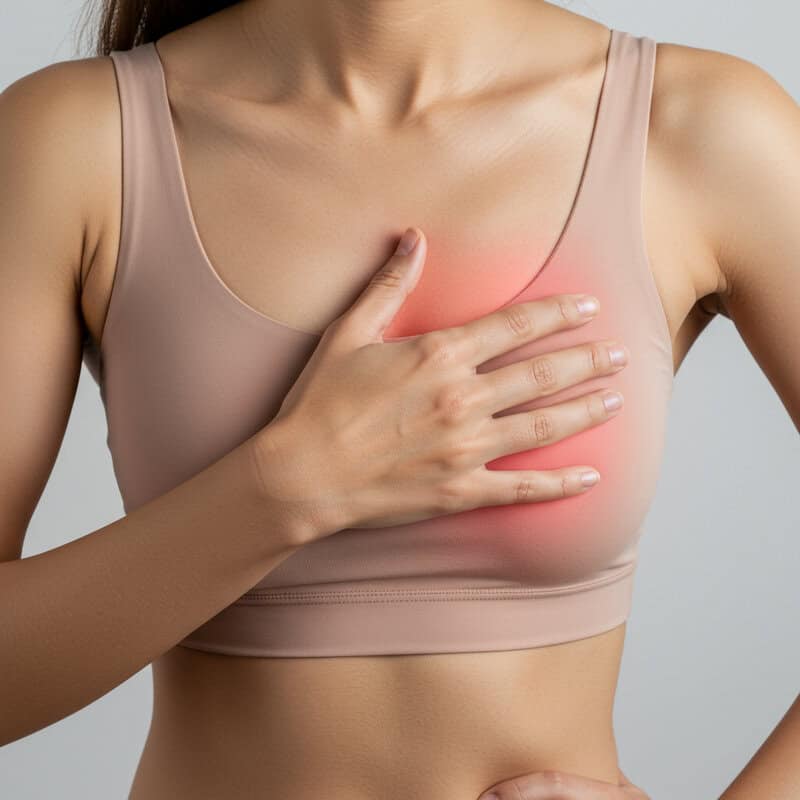
Pain in the breast or nipple is less commonly associated with breast cancer compared to other warning signs, but it should not be dismissed—especially if the pain is persistent and localized. Cancer-related breast pain can arise when a tumor presses on surrounding tissues or nerves, or when inflammation is present within the breast. While most breast pain is benign and linked to hormonal changes, infections, or injuries, unexplained discomfort deserves attention.
There are two main types of breast pain: cyclical and non-cyclical. Cyclical pain is related to hormonal fluctuations during the menstrual cycle and typically affects both breasts, subsiding after menstruation. In contrast, persistent (non-cyclical) pain tends to affect one area or one breast and does not correlate with the menstrual cycle. Persistent pain, especially when accompanied by other symptoms such as a lump, nipple changes, or skin abnormalities, should be evaluated by a healthcare provider.
To monitor breast pain, keep a diary noting the timing, duration, and location of the discomfort, as well as any associated changes. This information can help your provider determine if further testing or imaging is needed. For more details, visit the American Cancer Society.
9. Swelling of All or Part of the Breast
Swelling of all or part of the breast can be an important indicator of an underlying problem, including breast cancer. Cancer can cause inflammation and fluid buildup, leading to noticeable enlargement of the entire breast or a specific region. This swelling is not always accompanied by a lump and may make the skin appear tight or stretched. Swelling may also be associated with other symptoms such as redness, warmth, or changes in texture.
It’s important to differentiate cancer-related swelling from hormonal swelling, which often occurs as part of the menstrual cycle and typically affects both breasts in a symmetrical, mild manner. Hormonal swelling is usually temporary, subsiding after menstruation. In contrast, swelling due to breast cancer tends to be persistent, may affect only one breast or a specific area, and can appear suddenly or gradually over time.
Be particularly concerned if the swelling is accompanied by pain, skin dimpling, changes in nipple appearance, or any other unusual breast changes. Persistent or unexplained swelling should always be brought to the attention of a healthcare professional for further evaluation. For more information on this symptom, visit the Centers for Disease Control and Prevention (CDC).
10. Change in Skin Texture
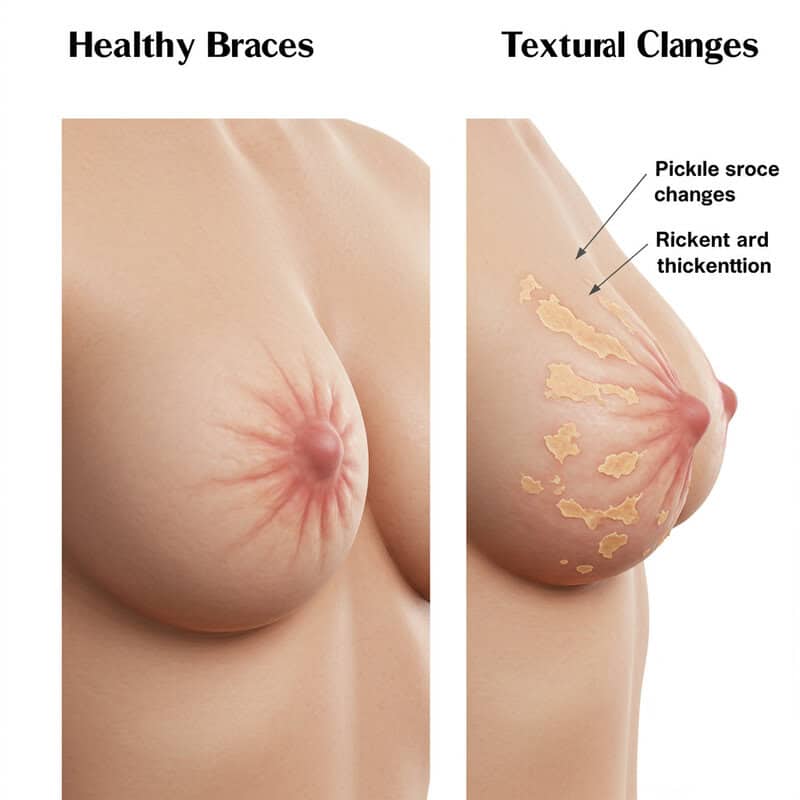
Changes in the texture of the breast skin—such as puckering, scaling, or thickening—can signal underlying breast cancer. These textural changes occur when cancer disrupts normal skin cells or lymphatic drainage, leading to abnormal appearances on the surface of the breast. Unlike healthy skin, which is typically smooth and even, affected skin may develop visible ridges, roughness, or flaky patches.
Puckering can present as small folds or indentations, sometimes resembling the surface of an orange (peau d’orange). Scaling or flaking may occur around the nipple or elsewhere on the breast and can be mistaken for eczema or other benign skin conditions. While minor skin irritation or dryness is common and often resolves quickly, persistent or worsening changes—especially when isolated to one area—require closer attention.
It is important to regularly examine your breasts and note any alterations in skin texture that do not heal or improve over time. Documenting these changes with photos or written notes can be helpful when consulting a healthcare provider. Prompt evaluation is essential, as early detection greatly improves treatment outcomes. For further details, visit the Breastcancer.org.
11. Itchy or Scaly Nipple
Itchy or scaly changes around the nipple can be a warning sign of breast cancer, particularly a rare form known as Paget’s disease of the breast. This condition involves cancer cells affecting the skin of the nipple and areola, causing persistent itchiness, redness, flaking, or crusting. These symptoms may also be accompanied by oozing or a burning sensation. While most cases of nipple itchiness are caused by benign issues such as dryness, allergies, or eczema, the persistence and location of symptoms are key factors to watch.
Eczema typically affects both nipples or other areas of the body and often improves with moisturizers and topical steroids. In contrast, cancer-related nipple changes usually involve one nipple, persist despite standard treatments, and may be associated with other symptoms like a lump, discharge, or changes in nipple shape. For example, a person might notice scaling and irritation that does not heal, even after using over-the-counter creams.
If you experience ongoing or worsening itchiness, scaling, or redness on one nipple, it’s important to seek medical evaluation promptly. Early diagnosis and treatment are critical. Learn more about Paget’s disease and related symptoms at the American Cancer Society.
12. Swollen Lymph Nodes
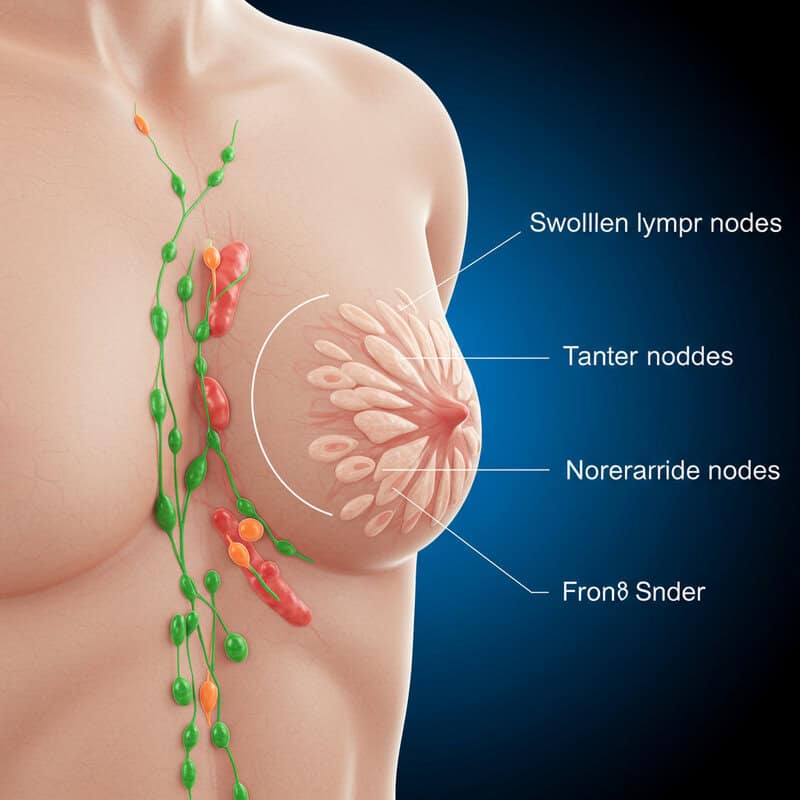
Swollen lymph nodes can be an important sign that breast cancer may have begun to spread beyond the breast tissue. The lymphatic system, which includes a network of nodes and vessels, plays a crucial role in filtering harmful substances and supporting the immune system. When breast cancer cells enter the lymphatic system, they often accumulate in nearby lymph nodes, causing them to become enlarged or tender.
The most common locations for swollen lymph nodes related to breast cancer are the axillary (underarm) region, just above or below the collarbone, and sometimes around the neck. These nodes may feel like firm, painless lumps or, in some cases, may become sore or tender. It is important to note that swollen lymph nodes can also be caused by infections or other benign conditions, but persistent swelling, especially when accompanied by other breast changes, should not be ignored.
If you notice unusual lumps or swelling in your underarm or around your collarbone, particularly if it does not resolve within a couple of weeks, consult your healthcare provider for further evaluation. Early assessment can help determine the cause and lead to prompt treatment if necessary. For more information, visit the American Cancer Society.
13. Unexplained Weight Loss

Unexplained weight loss can be a sign of advanced or metastatic breast cancer, as the disease may affect the body’s metabolism and overall health. Cancer cells can release substances that interfere with the way the body processes nutrients, leading to muscle wasting and fat loss even when appetite remains unchanged. This type of weight loss is often unintentional and occurs over weeks or months without significant changes in diet or exercise habits.
For example, someone might notice their clothes becoming looser or a sudden drop in weight on the scale without actively trying to lose pounds. They may experience fatigue, loss of appetite, or general malaise alongside the weight loss. While many factors such as stress, thyroid problems, or infections can also cause weight loss, when this symptom occurs with other warning signs like breast lumps, skin changes, or swollen lymph nodes, it may signal a more serious underlying issue.
It’s important to be aware of any significant, unintentional weight loss and to report this to your healthcare provider, especially if accompanied by other unusual symptoms. Early recognition can lead to timely diagnosis and intervention. For more on cancer-related weight loss, visit the National Cancer Institute.
14. Fatigue

Fatigue is a common yet often overlooked symptom associated with breast cancer, especially as the disease progresses. Cancer-related fatigue differs from ordinary tiredness—it tends to be persistent, overwhelming, and not relieved by rest or sleep. This type of exhaustion can result from the body’s response to cancer, which often releases inflammatory substances that disrupt normal energy production and function.
For instance, someone might notice they feel continually drained, even after a full night’s sleep or a restful weekend. Activities that were once easy—such as walking, climbing stairs, or running errands—may suddenly feel daunting. Unlike typical tiredness caused by a busy schedule, stress, or lack of sleep, cancer-related fatigue lingers and can worsen over time.
It’s important to distinguish between normal fluctuations in energy and persistent, unexplained fatigue that interferes with daily life. If you experience significant tiredness that does not improve with rest, especially when accompanied by other symptoms such as unexplained weight loss, lumps, or changes in the breast, it’s crucial to discuss these signs with your healthcare provider. For further information on cancer-related fatigue, visit the American Cancer Society.
15. Persistent Breast Warmth
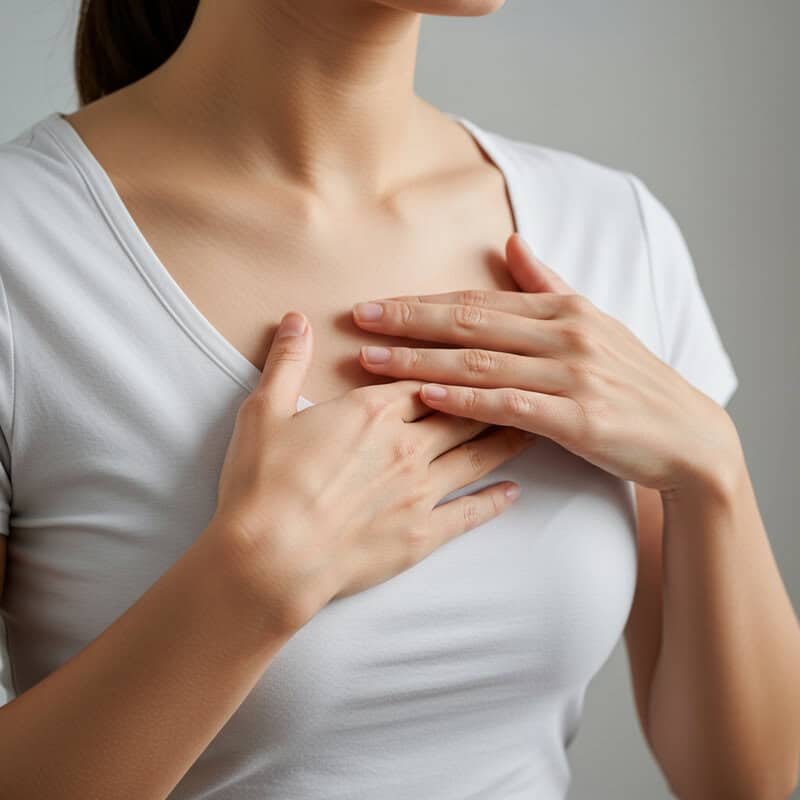
Persistent warmth in the breast can be a warning sign of an underlying problem, including inflammatory breast cancer. This rare but aggressive form of cancer can cause the breast to feel unusually warm to the touch due to increased blood flow and inflammation triggered by cancer cells blocking the lymphatic vessels. Unlike the temporary warmth experienced after exercise, exposure to heat, or hormonal changes, cancer-related warmth does not subside and is often accompanied by other symptoms such as redness, swelling, or tenderness.
For comparison, it is normal for breasts to feel warm after physical activity or during certain phases of the menstrual cycle, but this sensation typically passes quickly as your body returns to its baseline state. In contrast, persistent warmth—especially if it affects only one breast, occurs with no clear cause, or is associated with skin changes—should raise concern.
Pay attention to how your breasts normally feel and look for changes that last for several days or weeks. If you notice ongoing warmth, particularly when combined with other warning signs like redness, swelling, or thickening, consult your healthcare provider for a thorough evaluation. Learn more about inflammatory breast cancer at the National Cancer Institute.
16. Pitting Edema of the Breast
Pitting edema of the breast is a condition where pressing a finger into the breast tissue leaves a noticeable indentation that persists for several seconds. This occurs due to the accumulation of fluid in the soft tissue, which can be a sign of lymphatic obstruction often associated with inflammatory breast cancer. The buildup of fluid prevents normal drainage, causing the breast to appear swollen, heavy, and sometimes distorted in shape.
Pitting edema differs from general swelling because it is characterized by this “pitting” effect. While mild, temporary swelling can happen due to hormonal shifts, injury, or infection, persistent pitting edema is more concerning—especially when it affects only one breast or is accompanied by redness, warmth, or changes in skin texture. The underlying cause can be blockage of the lymph vessels by cancer cells, making this symptom an important warning sign.
To check for pitting edema, gently press your fingertip into a swollen area of the breast for a few seconds. If an indentation remains after you remove your finger, report this finding to your healthcare provider promptly. For more on identifying and understanding pitting edema, visit the Breastcancer.org.
17. Unexplained Bruising on the Breast

Unexplained bruising on the breast can be a concerning symptom, especially when it appears without any clear cause such as trauma or injury. While occasional mild bruising is common and may result from everyday bumps or increased sensitivity, spontaneous bruising that does not heal or is accompanied by other changes should not be ignored. In rare cases, underlying breast cancer—particularly inflammatory breast cancer—can damage blood vessels or affect local tissues, leading to visible bruising or discoloration.
Bruising related to cancer may occur because tumors disrupt the normal structure of blood vessels, making them more prone to leaking or bleeding even with minimal impact. The presence of a bruise without any recollection of injury, or the development of multiple or persistent bruises on the breast, can be a sign that further medical evaluation is needed.
If you notice a bruise that is not fading, is spreading, or is paired with other symptoms such as swelling, warmth, or changes in skin texture, it’s important to seek assessment promptly. Early evaluation helps rule out serious underlying causes. For more information about when breast changes require attention, visit the Cancer Treatment Centers of America.
18. Visible Vein Changes
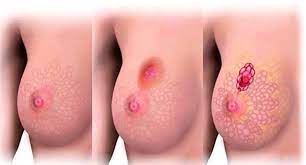
Visible vein changes on the breast can sometimes be a sign of an underlying issue, including breast cancer. Normally, some veins may be faintly visible under the skin, especially in people with lighter skin tones or thinner tissue. However, a sudden appearance of prominent, enlarged, or darkened veins that were not previously noticeable can be a red flag. This may occur when a tumor disrupts normal blood flow or causes increased blood supply to the breast, resulting in more visible or engorged veins.
For example, someone may observe that a web of blue or purple veins has become increasingly pronounced across one breast, or that a single vein appears raised and more prominent than usual. These changes are particularly concerning if they are accompanied by other symptoms such as swelling, redness, warmth, or a change in breast size or shape.
It is important to distinguish between normal vein patterns—which tend to remain stable over time—and new or rapidly changing vascular prominence. If you notice new, enlarged, or unusually visible veins on your breast, especially alongside other warning signs, consult a healthcare provider for assessment. For more details, visit the Breastcancer.org.
19. Sore or Ulcerated Nipple
Sore or ulcerated nipples can be a significant sign of breast cancer, particularly forms such as Paget’s disease. Nipple ulceration refers to the development of open sores, persistent rawness, or non-healing wounds on or around the nipple. Unlike minor abrasions caused by friction from clothing, breastfeeding, or accidental scratching—which typically heal within a few days—cancer-related ulcers persist, often worsen, and are less responsive to over-the-counter treatments.
The underlying cause of nipple ulceration in breast cancer is the invasion of malignant cells into the skin’s surface, disrupting the normal healing process and causing chronic, sometimes painful, lesions. These sores may ooze, bleed, or create a crusty layer that repeatedly returns after removal. A person might also notice associated symptoms such as redness, swelling, or changes in the nipple’s shape.
Prompt medical attention is crucial if you observe a sore, ulcer, or wound on the nipple that does not heal in a week or two, especially if accompanied by other symptoms like discharge or skin changes. Early evaluation can lead to timely diagnosis and improved outcomes. For more information, visit the American Cancer Society.
20. Peeling or Flaking of Nipple Skin
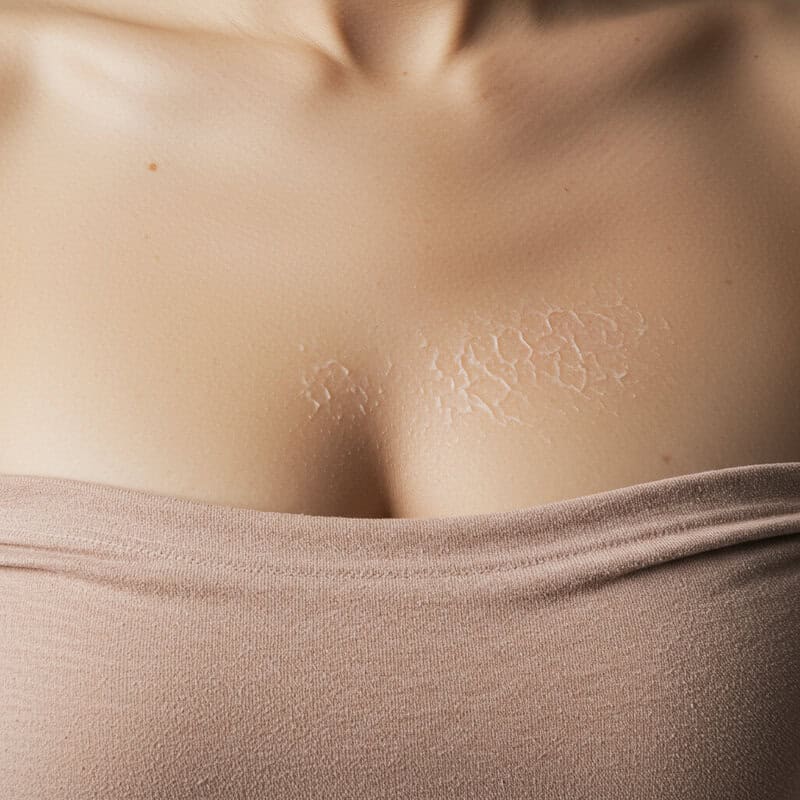
Peeling or flaking of the nipple skin can be a subtle but important warning sign of breast cancer, particularly Paget’s disease of the nipple. This symptom may present as dry, scaly, or flaky patches on or around the nipple and areola. While minor peeling can occur due to dry skin, irritation from clothing, or weather changes, cancer-related peeling tends to persist and may be accompanied by other changes such as redness, itching, or a burning sensation.
Benign causes of nipple peeling, such as eczema or contact dermatitis, usually affect both nipples or other areas of the body and improve with moisturizers or topical treatments. In contrast, peeling or flaking caused by cancer typically involves only one nipple and does not resolve with standard remedies. Additionally, it may be associated with a lump, nipple discharge, or ulceration.
If you notice persistent or worsening peeling, flaking, or scaling of the nipple skin—especially if it is isolated to one side or accompanied by other concerning symptoms—it is important to seek evaluation by a healthcare provider. Early diagnosis can make a significant difference. For further information, visit the Breastcancer.org.
21. Pain in the Armpit
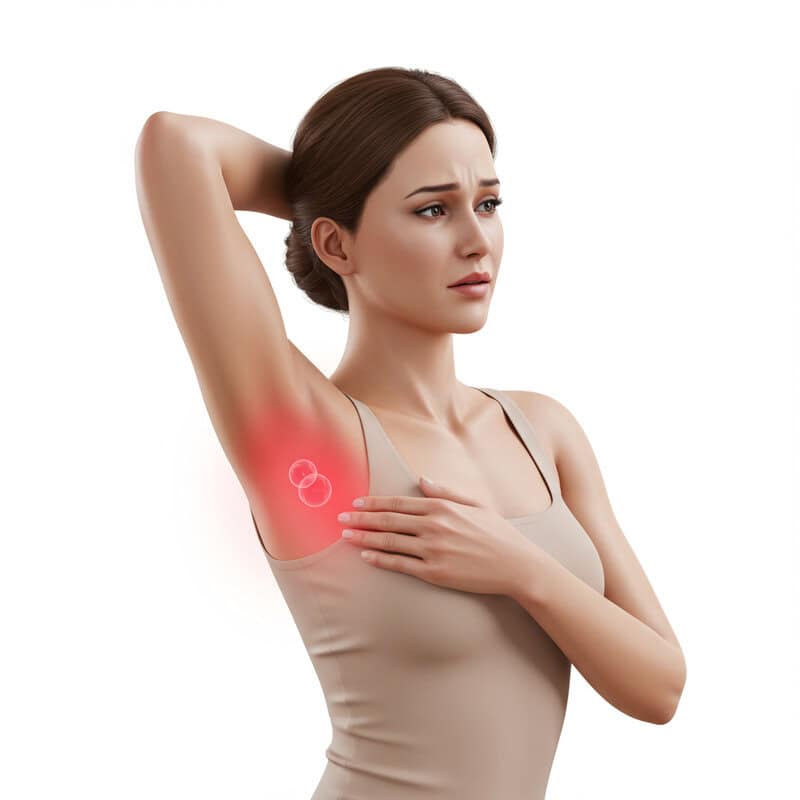
Pain in the armpit can be an important, though sometimes overlooked, warning sign of breast cancer. This discomfort is often linked to the involvement of lymph nodes located in the axillary (underarm) region, which are a key part of the body’s lymphatic system. When breast cancer spreads, it can cause these lymph nodes to become swollen, tender, or painful due to inflammation or direct invasion by cancer cells.
For example, someone might notice a dull ache in one armpit that persists for several days, or feel discomfort when lifting their arm, carrying bags, or wearing tight clothing. While muscle strain, infection, or shaving irritation can also cause armpit pain, such causes typically resolve quickly or affect both sides. In contrast, persistent or worsening pain in just one armpit—especially when accompanied by a lump, swelling, or other breast changes—may warrant closer attention.
It is important to monitor any ongoing armpit pain that does not improve with rest or over-the-counter remedies. If you experience unexplained or new pain in the underarm area, especially with other symptoms, consult your healthcare provider. For more on lymph node involvement and related symptoms, visit the American Cancer Society.
22. Nipple Position Change
Changes in nipple position can be an early and subtle indicator of breast cancer. Tumors or abnormal tissue growth within the breast can pull on ligaments and underlying structures, causing the nipple to shift its usual orientation. This might mean the nipple points in a new direction, appears higher or lower than before, or seems to tilt to one side. These changes are often gradual and may go unnoticed without close observation.
For example, you may notice that the nipple on one breast no longer aligns with the other when looking in the mirror or that it points inward, downward, or to the side instead of its typical outward direction. Sometimes, such shifts are only visible when raising your arms or changing your posture. Unlike temporary changes that can occur with hormonal fluctuations or cold temperatures, cancer-related changes are persistent and do not resolve on their own.
To monitor for positional changes, regularly observe your breasts in good lighting and check your nipple alignment from multiple angles. Taking periodic photos or making notes can help track subtle differences over time. If you notice a persistent change in nipple position, consult your healthcare provider. Learn more at Breastcancer.org.
23. Breast Pain Not Related to Menstrual Cycle

Breast pain that is not related to the menstrual cycle—also known as non-cyclical breast pain—can be a cause for concern, particularly if it is persistent and localized. Unlike the common tenderness or fullness many people experience in both breasts just before or during menstruation, non-cyclical pain is not linked to hormonal changes and often affects only one breast or a specific area within the breast.
For example, someone may experience a sharp, burning, or aching sensation in the same spot of one breast for weeks, or notice that the pain does not subside after their period has ended. This type of discomfort can sometimes be associated with an underlying breast abnormality, including infection, cysts, or, less frequently, cancer. While most non-cyclical breast pain is not due to cancer, it is important to be vigilant, especially if the pain is new, worsening, or accompanied by other symptoms such as lumps, skin changes, or nipple discharge.
If you notice persistent, unexplained pain in your breast that does not fluctuate with your monthly cycle, it’s wise to consult a healthcare provider for further evaluation. For more insight into breast pain and when to seek help, visit the American Cancer Society.
24. Breast Fullness Sensation
A sensation of fullness in the breast can be an early and subtle indicator of breast abnormalities, including cancer. This feeling is often described as heaviness, tightness, or increased pressure within one or both breasts. The sensation may be constant or may gradually intensify over time. It can be similar to the engorgement feeling experienced during breastfeeding—when the breasts become swollen and uncomfortable due to milk accumulation—but in cases of cancer, the fullness is not related to lactation or hormonal changes.
While many people experience temporary fullness as part of their menstrual cycle, such sensations are usually symmetrical and resolve once the cycle ends. In contrast, cancer-related fullness tends to be persistent, localized to one breast, and may be accompanied by other symptoms like swelling, a lump, or changes in skin texture. Sometimes, the breast may also feel firmer or heavier than usual, even without visible enlargement.
If you notice an ongoing sense of fullness—especially if it is new, one-sided, or persists beyond your menstrual period—it’s advisable to seek medical evaluation. Early detection is crucial for effective treatment. For more information on breast fullness and related symptoms, visit the Centers for Disease Control and Prevention (CDC).
25. Skin Ulceration

Skin ulceration on the breast is a serious sign often associated with advanced or neglected breast cancer. Ulceration occurs when the skin breaks down, forming an open sore or wound that does not heal. This is typically the result of a tumor growing through the skin’s surface, disrupting normal tissue and blood supply. The ulcer may appear as a raw, red, or bleeding area, sometimes with a foul odor or discharge.
Visually, a cancer-related ulcer can resemble a persistent sore or crater-like lesion, much larger and deeper than a minor abrasion or scratch. Unlike superficial cuts that heal within days, these ulcers remain open, can increase in size, and may become infected. In some cases, the surrounding skin is swollen, hardened, or discolored. The presence of skin ulceration is a sign that the cancer has progressed significantly and requires immediate medical intervention.
If you or someone you know develops an open wound or ulcer on the breast that does not improve, it is critical to seek urgent medical care. Early treatment can help prevent complications and improve outcomes. For more information about skin changes in breast cancer, visit the American Cancer Society.
26. Breast Skin Color Changes

Changes in the color of the breast skin can be a significant warning sign of underlying breast cancer, particularly inflammatory breast cancer. Discoloration may present as redness, a purplish hue, or even a bluish tint in the affected area. These color changes are typically distinct from the mild pinkness caused by irritation, shaving, or heat rash. Unlike temporary flushes or bruises from minor trauma, cancer-related discoloration is persistent and often accompanied by other symptoms such as swelling, warmth, or tenderness.
For example, a person might notice a red patch that gradually spreads across one breast, or a purplish area that resembles a bruise but does not fade. In some cases, the skin may take on a mottled or blotchy appearance. These changes may be subtle at first but progress over time and are often resistant to topical treatments. Discoloration from breast cancer is usually localized to one breast and does not improve with rest or home remedies.
If you observe any persistent changes in breast skin color—especially redness or purple discoloration that does not resolve within a few days—it is important to seek medical evaluation promptly. For more guidance on identifying breast cancer symptoms, visit the Centers for Disease Control and Prevention (CDC).
27. Orange Peel Texture (Peau d’Orange)

Orange peel texture, also known as peau d’orange, is a distinctive skin change that can be a warning sign of inflammatory breast cancer. This effect occurs when the skin of the breast becomes thickened and dimpled, closely resembling the surface of an orange. The primary cause is lymphatic blockage—cancer cells infiltrate the lymph vessels in the skin, leading to fluid buildup and localized swelling.
This texture may be seen as small pits or indentations, often around the areola or across a larger area of the breast. Unlike simple skin dimpling caused by minor injuries, peau d’orange is usually persistent, affects only one breast, and is frequently associated with redness, warmth, or swelling. The skin may feel firmer and less pliable than usual.
To observe for this change, examine your breasts in good lighting and gently press the skin to see if any indentations remain. Compare both breasts for symmetry. If you notice a persistent orange peel effect or other unusual textural changes, seek prompt medical evaluation. Early detection is vital for effective treatment. For more details on this symptom, visit American Cancer Society.
28. Sudden Increase in Breast Size
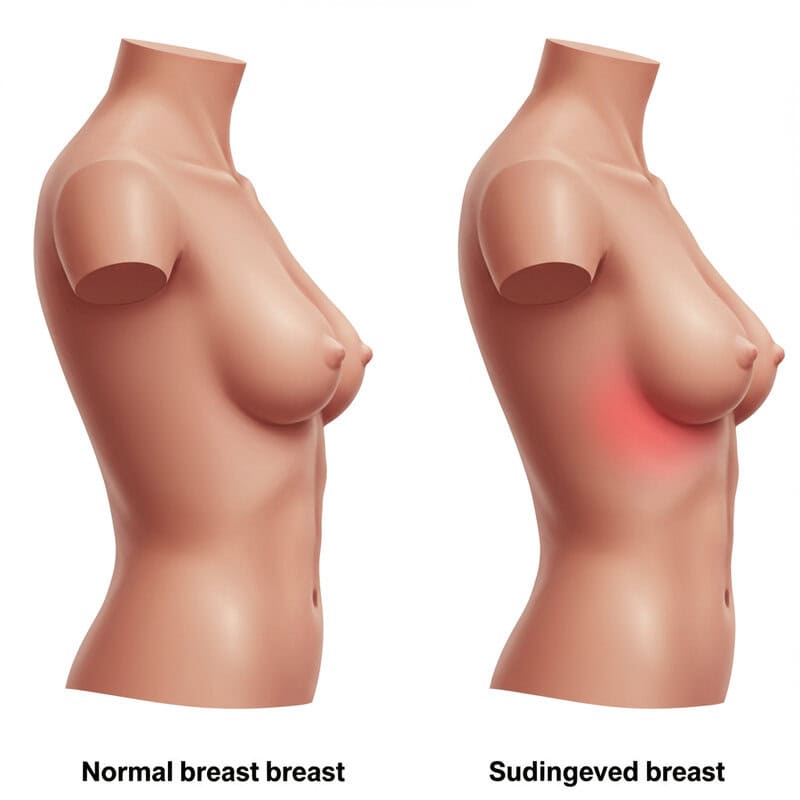
A sudden increase in breast size is an unusual change that may indicate an underlying condition, including inflammatory breast cancer. Rapid swelling or enlargement of one breast is particularly concerning, as it is rarely related to hormonal shifts, weight gain, or normal aging. The size difference may develop over days or weeks, rather than gradually, and is often accompanied by other symptoms such as redness, warmth, or skin thickening.
For example, someone might notice that one breast no longer fits comfortably in their usual bra, or that clothes appear uneven. This change can be especially apparent when looking in the mirror or comparing both breasts while standing. Unlike the mild, cyclical swelling that may occur before menstruation, a rapid and persistent increase in size—especially if only one breast is affected—should not be ignored.
If you observe a sudden or unexplained increase in breast size, it is important to consult a healthcare provider as soon as possible. Early assessment may involve a physical examination, imaging, or biopsy to determine the underlying cause. For more information on serious breast changes and next steps, visit the Cancer Treatment Centers of America.
29. Deviation of Nipple Direction
Deviation of nipple direction refers to a noticeable shift in the orientation or angle of one or both nipples compared to their usual baseline. This change can occur when underlying breast tissue or ligaments are affected by a tumor, causing the nipple to be pulled or pushed in a new direction. While minor fluctuations in nipple direction can occur due to changes in temperature or hormonal cycles, a persistent and unexplained deviation is more concerning.
For example, someone might notice that a nipple once pointed forward now consistently angles downward, upward, or to the side, even when at rest. This deviation can become apparent when standing in front of a mirror and comparing both breasts for symmetry, or when noticing an altered fit in clothing. Unlike temporary changes that resolve on their own, a cancer-related deviation will persist regardless of external factors.
To self-monitor, regularly observe your breasts from multiple angles and in different lighting conditions. Take note of any lasting changes in the direction your nipples face and track them over time. If you identify a deviation that does not resolve or is associated with other warning signs, consult a healthcare provider. For more information, visit Breastcancer.org.
30. Increased Breast Firmness

Increased breast firmness can be an important sign of underlying breast changes, including cancer. While it is normal for breast tissue to feel dense or firm, especially in younger individuals or those with fibrocystic breasts, abnormal or persistent firmness that arises suddenly or is localized to one area is more concerning. Cancerous tumors or the surrounding fibrous tissue may cause the breast to feel harder or less pliable than usual.
For example, during a self-exam, you may notice that one breast—or a specific section of it—feels noticeably firmer or stiffer than the other. This firmness does not fluctuate with the menstrual cycle and remains even after hormonal changes have resolved. In contrast, normal breast density is typically soft or rubbery and may vary in different parts of the breast or throughout the month.
Persistent, unexplained firmness that does not subside and is different from your usual breast texture should be evaluated by a healthcare provider. Keeping track of changes with regular self-exams can help you identify when something feels off. For more guidance on breast self-exams and firmness, visit the American Cancer Society.
31. Persistent Localized Breast Pain

Persistent localized breast pain is a symptom that should not be ignored, especially when the pain is confined to a specific area and does not resolve over time. While breast pain is often linked to benign conditions such as hormonal fluctuations, cysts, or muscle strain, cancer-related pain tends to linger, intensify, or become more pronounced regardless of menstrual cycles or physical activity.
A relatable scenario might involve someone experiencing a sharp, aching, or burning sensation in one particular spot on the breast that persists for several weeks. Unlike general breast tenderness that comes and goes with hormonal changes, this discomfort remains fixed in location, even when using over-the-counter pain relievers or changing physical routines. It may interfere with sleep or daily activities and is sometimes accompanied by other warning signs like a lump or skin change.
If you notice pain in one part of your breast that lasts more than a couple of weeks, it’s important to track its duration and any associated symptoms. Documenting when the pain occurs, its severity, and whether it worsens can be helpful for your healthcare provider. For more information about breast pain and when it warrants medical attention, visit the American Cancer Society.
32. Itching That Doesn’t Go Away

Persistent itching of the breast or nipple can be an overlooked but important warning sign, especially when it does not respond to typical remedies. While most itching is caused by allergies, dry skin, or irritation from fabrics and detergents, these types of itchiness typically resolve quickly with moisturizing, antihistamines, or changing products. In contrast, cancer-related itching tends to be stubborn, affecting the same spot for weeks or months, and may not improve with standard treatments.
For example, someone might notice a constant itch on the skin of one breast or around the nipple that becomes distracting and even disrupts sleep. Unlike allergic reactions, which often present with widespread rash or redness, cancer-related itch is usually localized, persistent, and may be accompanied by other changes such as redness, scaling, or thickening of the skin.
If you experience ongoing itching that does not resolve within a week or two, or if it is accompanied by other symptoms like flaking, swelling, or a lump, it is important to seek medical evaluation. Persistent itching can be an early indicator of inflammatory breast cancer or Paget’s disease. For more on breast cancer symptoms, visit Breastcancer.org.
33. Nipple Crusting
Nipple crusting refers to the formation of a hard, flaky layer on the surface of the nipple or areola. This crust can develop as a result of dried fluid—such as discharge or blood—on the skin. While occasional crusting can occur due to benign causes like eczema, dermatitis, or irritation from friction, these usually improve with gentle cleansing and over-the-counter creams. Benign crusting is often temporary, affects both nipples, and is rarely associated with other changes.
However, persistent or recurring nipple crusting, especially on just one side, may indicate an underlying problem such as Paget’s disease of the breast or another form of cancer. Cancer-related crusting is often accompanied by symptoms like redness, scaling, itching, or oozing from the nipple. The crust may reform even after being gently removed, and the area may feel sore or tender.
To assess nipple crusting, monitor how long it lasts, whether it returns after cleaning, and if there are any additional symptoms like a lump or skin changes. If the crusting persists for more than a week, or if it is one-sided and unresponsive to basic care, consult a healthcare provider. For further information, visit American Cancer Society.
34. Burning Sensation in Breast
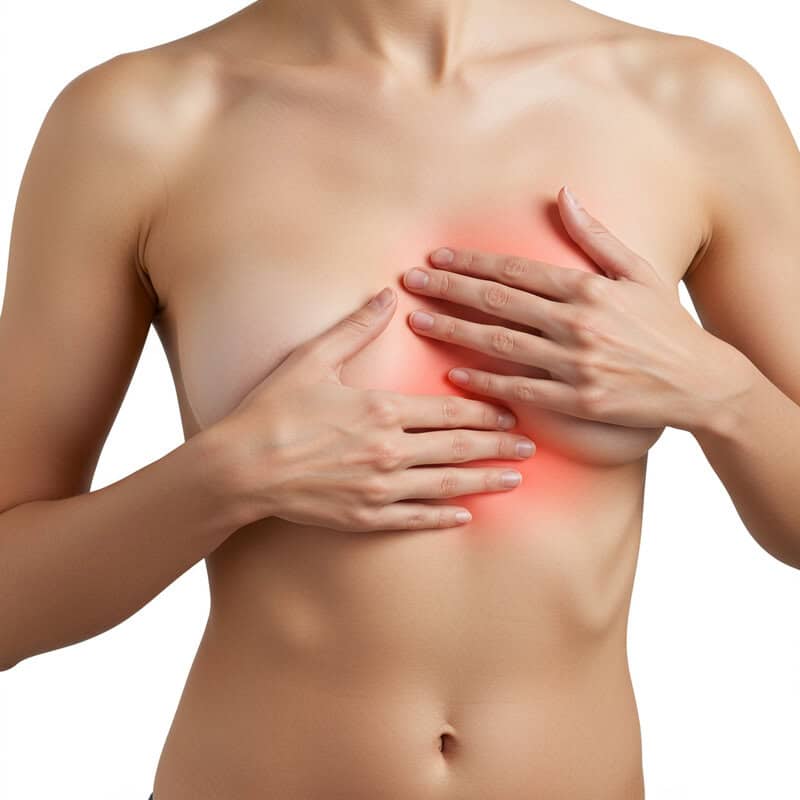
A burning sensation in the breast can be a troubling symptom that warrants attention, especially when it is persistent and localized. This type of pain is often described as a warm, tingling, or stinging feeling within the breast tissue. While occasional burning may be linked to benign causes such as muscle strain, skin irritation, or infections, it can also signal underlying breast cancer, particularly if it does not improve with basic care.
Burning pain differs from nerve pain, which may result from conditions like shingles or neuropathy and often radiates outward or is accompanied by numbness or tingling in other areas. Cancer-related burning typically stays in one area, may intensify over time, and can be associated with other symptoms such as redness, swelling, or a palpable lump. For example, a person may notice a consistent burning sensation in one section of the breast that does not change with movement or touch.
If you experience burning pain in your breast that lasts more than a few days, especially if it is confined to one area or comes with other changes, it is important to consult your healthcare provider. Early evaluation can help identify the cause and guide treatment. For additional information, visit the American Cancer Society.
35. Breast Heaviness

Breast heaviness is a subtle symptom that can sometimes indicate underlying breast cancer. This sensation is often described as a feeling of weight, pressure, or dragging in one or both breasts, even if there is no visible swelling or enlargement. Heaviness may be likened to the sensation of carrying a small weight or wearing a water-filled pad inside the bra, and it can persist throughout the day regardless of activity or rest.
While breast heaviness can occasionally occur due to hormonal changes, such as before menstruation or during pregnancy, these fluctuations are usually temporary and affect both breasts equally. In contrast, persistent heaviness that affects only one breast, or does not resolve after your cycle or with time, may be a warning sign of a more serious condition, including the presence of a tumor or inflammation within the breast tissue.
If you experience ongoing breast heaviness, it is important to track the duration, whether it is isolated to one side, and if it is accompanied by other symptoms like pain, firmness, or skin changes. Keeping a symptom diary can be helpful for healthcare evaluation. For more guidance on breast cancer symptoms, visit the American Cancer Society.
36. Nipple Scaling
Nipple scaling refers to the development of dry, flaky, or rough skin on the surface of the nipple or areola. This symptom often appears as fine, white or yellowish flakes that may be easily brushed away, or as patches of rough, thickened skin. While mild scaling can be associated with common conditions like eczema or irritation from friction, persistent scaling that does not improve with moisturizing or over-the-counter creams may be a warning sign of an underlying issue such as Paget’s disease of the breast or another form of breast cancer.
Visually, scaling may look like small, peeling layers of skin or crusty patches that recur even after gentle cleaning. The area may also become red, itchy, or slightly swollen. Unlike benign skin irritations that typically affect both nipples or other parts of the body, cancer-related nipple scaling is often isolated to one nipple and may be accompanied by other symptoms, such as a lump, discharge, or persistent soreness.
If you notice nipple scaling that lasts more than a week, recurs after treatment, or is linked with other changes, consult a healthcare provider for evaluation. Early recognition is key. For more information, visit American Cancer Society.
37. Breast Skin Ulcers That Do Not Heal

Breast skin ulcers that do not heal are a serious and urgent warning sign, often associated with advanced or aggressive breast cancer. Unlike minor cuts, scrapes, or abrasions—which typically heal within a few days to a week—cancer-related skin ulcers remain open, progressively worsen, or even enlarge over time. These non-healing wounds may appear as raw, red, or bleeding areas, sometimes with a foul odor or discharge, and are resistant to standard wound care or topical treatments.
For example, someone might notice a sore on the surface of the breast that starts small but gradually becomes larger or deeper, with no signs of healing even after cleansing and covering. Unlike everyday injuries, these ulcers can be surrounded by hardened, discolored, or swollen skin and may be painful or tender to the touch. The presence of such a wound often signifies that the tumor has invaded the skin, causing tissue breakdown and preventing normal recovery.
If you or someone you know develops a breast ulcer that does not heal within two weeks, it is crucial to seek prompt medical attention for a thorough evaluation and treatment. Early intervention can significantly affect outcomes. For more information, visit the American Cancer Society.
38. Changes in Sensation (Numbness or Tingling)
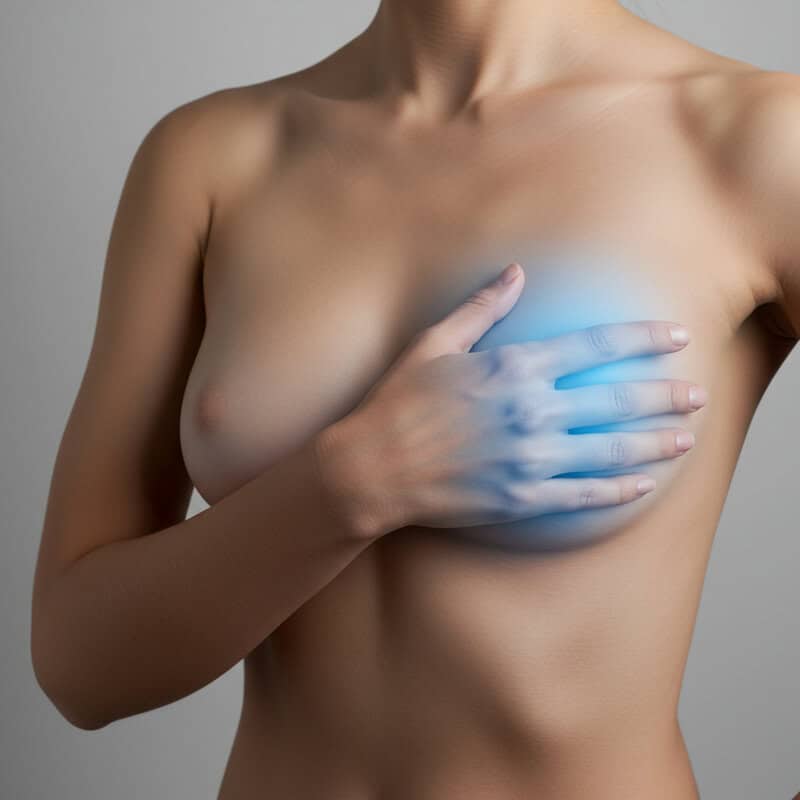
Changes in breast sensation, such as numbness or tingling, can be an important indicator of underlying breast cancer. These sensory changes often occur when a tumor grows and begins to press on surrounding nerves, disrupting normal nerve signals. While occasional tingling or numbness can result from temporary pressure on the breast—such as sleeping in an awkward position—persistent or unexplained changes in sensation deserve closer attention.
For instance, someone may notice a patch of skin on the breast or nipple that feels less sensitive to touch, or a persistent “pins and needles” sensation that wasn’t there before. This numbness or tingling may stay in one area or slowly spread, and it is not relieved by shifting positions, massaging the area, or wearing different clothing. Such sensations are often subtle at first but can become more noticeable over time, especially if associated with other symptoms like a lump, swelling, or skin changes.
To check for sensory changes, gently touch different areas of your breast and compare sensations on both sides. If you detect persistent numbness, tingling, or any loss of sensation, report these findings to your healthcare provider. For more information, visit the American Cancer Society.
39. Prominent or New Lumps in Armpit
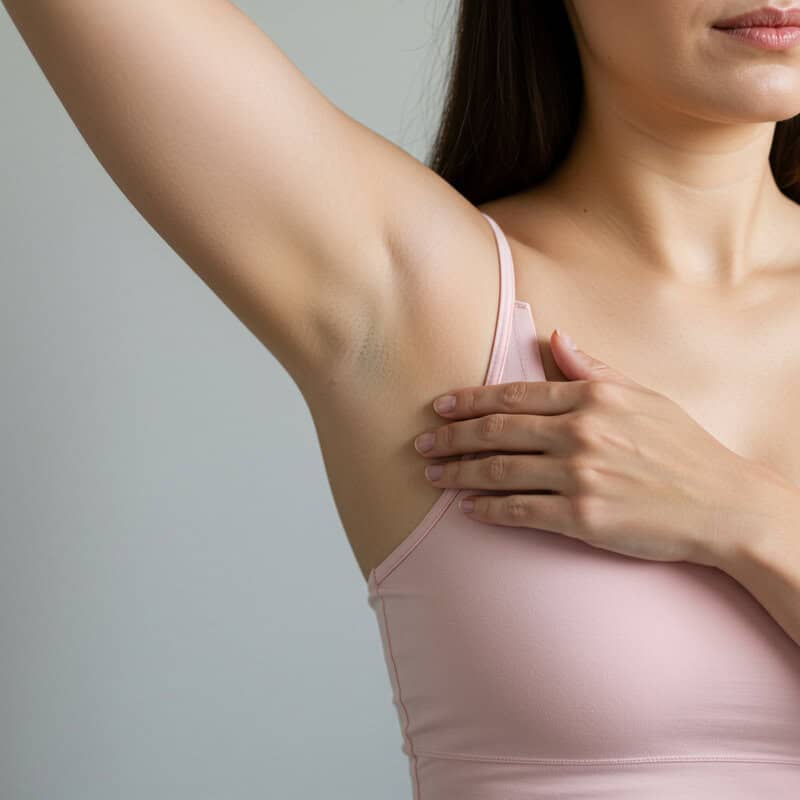
Prominent or new lumps in the armpit are often related to changes in the lymph nodes, which play a key role in filtering harmful substances and fighting infection. When breast cancer cells spread, they commonly travel first to the lymph nodes in the axillary (underarm) area, causing them to swell and form noticeable lumps. These lumps can be firm, painless, or tender, and are usually more prominent on one side.
A real-world example could be noticing a new lump in your underarm while shaving, applying deodorant, or during a self-exam. Unlike lumps caused by infections—which may be sore, red, and resolve within a few days—cancer-related lymph node lumps persist, grow, or become increasingly firm over time. Sometimes, these lumps are the first noticeable sign of breast cancer before any changes are detected in the breast itself.
If you discover a new or enlarging lump in your armpit, especially if it does not go away after a week or two or is accompanied by other breast changes, seek prompt evaluation by a healthcare provider. Early assessment can lead to timely diagnosis and better outcomes. For more details on symptoms, visit the American Cancer Society.
40. Unilateral Breast Changes
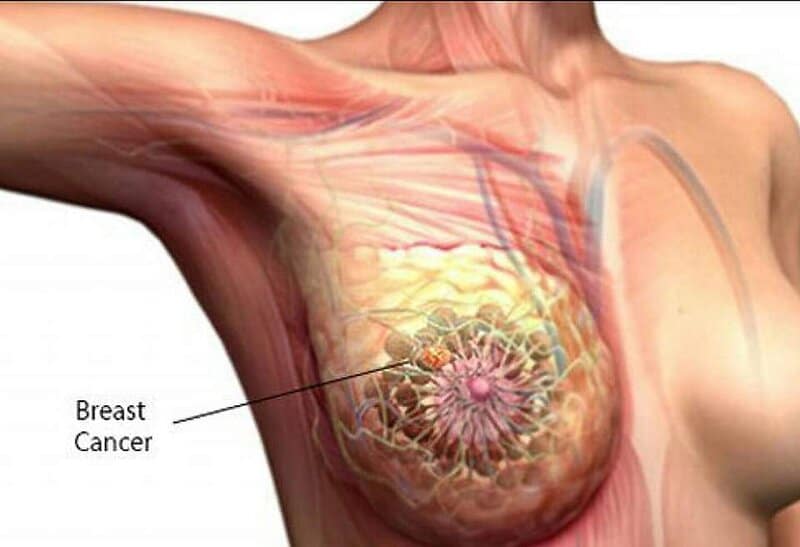
Unilateral breast changes refer to symptoms or alterations that occur in only one breast, rather than affecting both sides equally. These changes are particularly significant because most benign breast conditions and hormonal fluctuations tend to impact both breasts in a similar manner. Unilateral changes can include swelling, redness, firmness, nipple discharge, skin dimpling, or the appearance of a lump confined to a single breast.
For example, you might notice that only your left breast has become noticeably fuller, firmer, or more tender, or that the nipple on one side has started to invert or develop a persistent rash. In contrast, bilateral changes—such as mild tenderness or fullness before menstruation—are usually symmetrical and temporary. Unilateral symptoms that do not resolve with time or after your menstrual cycle may signal a more serious underlying issue, such as breast cancer.
If you experience any persistent, one-sided changes in your breast tissue, nipple, or skin that are not mirrored on the opposite side, it is important to seek prompt medical evaluation. Early recognition and follow-up can make a critical difference in outcomes. For more information on breast changes and when to seek help, visit the American Cancer Society.
41. Spontaneous Nipple Discharge
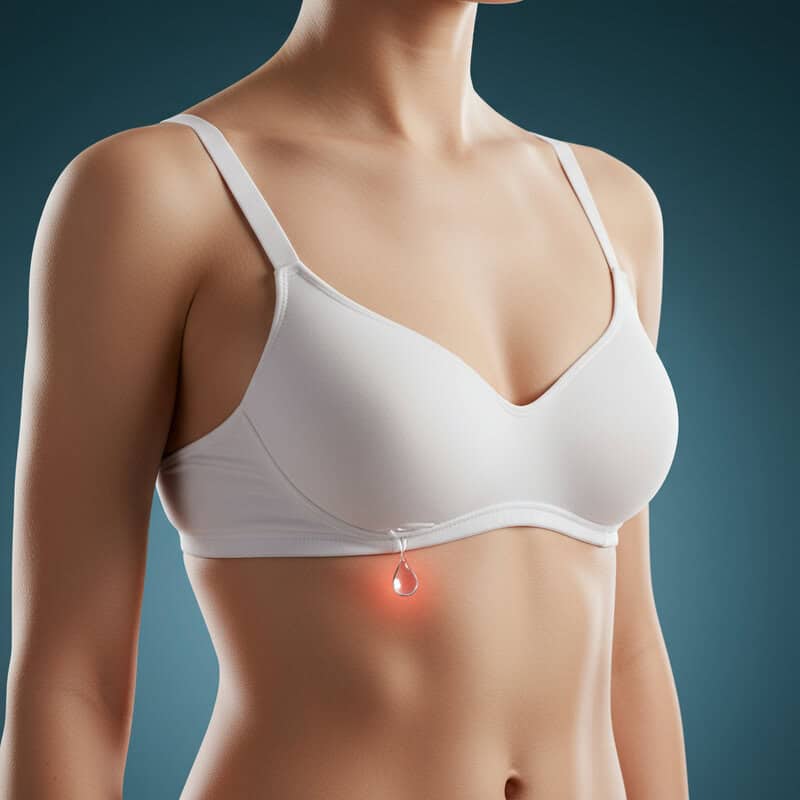
Spontaneous nipple discharge refers to fluid leaking from the nipple without any squeezing, stimulation, or pressure. This type of discharge can be alarming and is particularly concerning when it occurs from only one breast, is persistent, and is not related to pregnancy or breastfeeding. The color and consistency of the discharge provide important clues: clear, bloody, or straw-colored discharge is more worrisome than milky or greenish fluid, which is often associated with benign conditions.
For example, you might notice a stain on your bra or find that fluid has leaked onto your clothing overnight without any provocation. While some discharge can result from hormonal fluctuations or benign growths like papillomas, unprovoked or spontaneous discharge—especially if it is bloody or watery—may be a sign of an underlying malignancy such as ductal carcinoma in situ (DCIS) or Paget’s disease of the nipple.
If you experience any spontaneous or unexplained nipple discharge, particularly if it is persistent or accompanied by other symptoms like a lump or skin changes, seek prompt evaluation by a healthcare provider. Early investigation is crucial for accurate diagnosis and timely treatment. For more information, visit the American Cancer Society.
42. Loss of Nipple Sensitivity
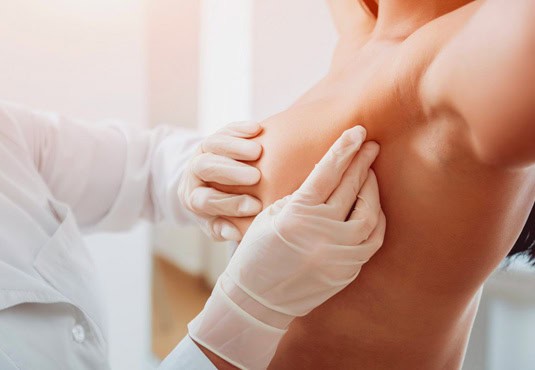
Loss of nipple sensitivity is a subtle but noteworthy symptom that may be associated with breast cancer. Normally, the nipples are quite sensitive to touch, temperature changes, and stimulation. A sudden or gradual reduction in this sensation—where the nipple feels numb, less responsive, or even completely insensate—can occur when a tumor presses on or invades the nerves supplying the area.
While brief changes in sensitivity can happen due to cold exposure, friction, or hormonal shifts, these effects are typically short-lived and resolve on their own. In contrast, cancer-related loss of sensitivity tends to persist and may affect only one nipple. For example, you might notice that one nipple no longer responds to touch or feels “dull” compared to the other side, even during activities that used to trigger a reaction.
If you experience a persistent decrease or absence of nipple sensitivity—especially when it is limited to one side or associated with other symptoms like skin changes, lumps, or discharge—it is important to consult a healthcare provider promptly. Early evaluation can help determine the cause and ensure timely treatment. For further details, visit the American Cancer Society.
43. Breast Skin Thickening
Breast skin thickening refers to an area of the breast where the skin feels denser, firmer, or less pliable than the surrounding tissue. This can be a subtle but important indicator of an underlying issue, including breast cancer. The thickening occurs when abnormal cells accumulate, causing local inflammation or fibrosis, which alters the skin’s texture and elasticity. Unlike normal, soft breast skin, thickened skin may feel more like the surface of an orange peel or a leather patch.
For example, you might notice an area on your breast that feels unusually tough, almost like there’s a layer of rubber beneath the skin, or that does not “give” as easily when pressed compared to the rest of your breast. This change is often persistent and can develop gradually, making it easy to overlook unless you perform regular self-exams.
To monitor for skin thickening, use your fingertips to gently press and move over all areas of your breasts, noting any spots that feel different or firmer than usual. If you notice persistent thickening or any new area that feels abnormal, consult your healthcare provider. For more information, visit the American Cancer Society.
44. Sudden Breast Tenderness
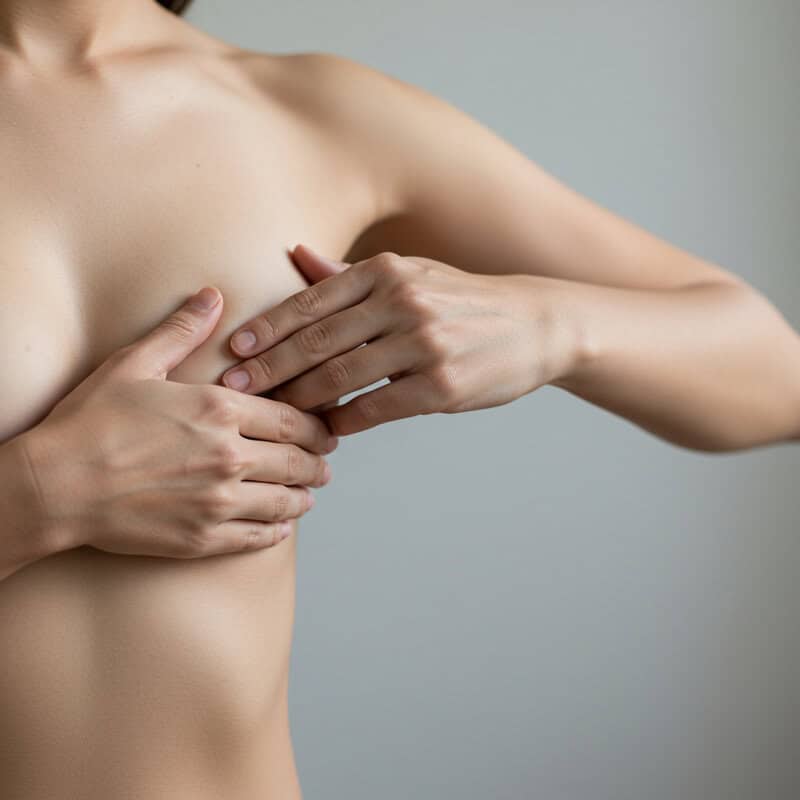
Sudden breast tenderness refers to the abrupt onset of soreness or increased sensitivity in one or both breasts. While it’s common to experience mild breast tenderness related to hormonal fluctuations—such as before menstruation, during pregnancy, or with certain medications—this type of discomfort is usually predictable, affects both breasts, and resolves over time. In contrast, sudden, unexplained tenderness that appears out of nowhere and remains persistent can be a cause for concern.
For instance, you might notice that one breast becomes sensitive to touch, clothing, or even gentle pressure, without any clear reason or recent injury. The tenderness may not subside with the end of your menstrual cycle, and it might be accompanied by other symptoms like swelling, redness, or a localized lump. Unlike normal soreness, which is often dull and widespread, cancer-related tenderness can be sharper, more localized, and persistent.
Red flags include tenderness that does not resolve within a week or two, is associated with visible skin changes, or is limited to just one breast. If you experience any of these warning signs, seek prompt evaluation from a healthcare provider. For additional information, visit the American Cancer Society.
45. Persistent Nipple Pain
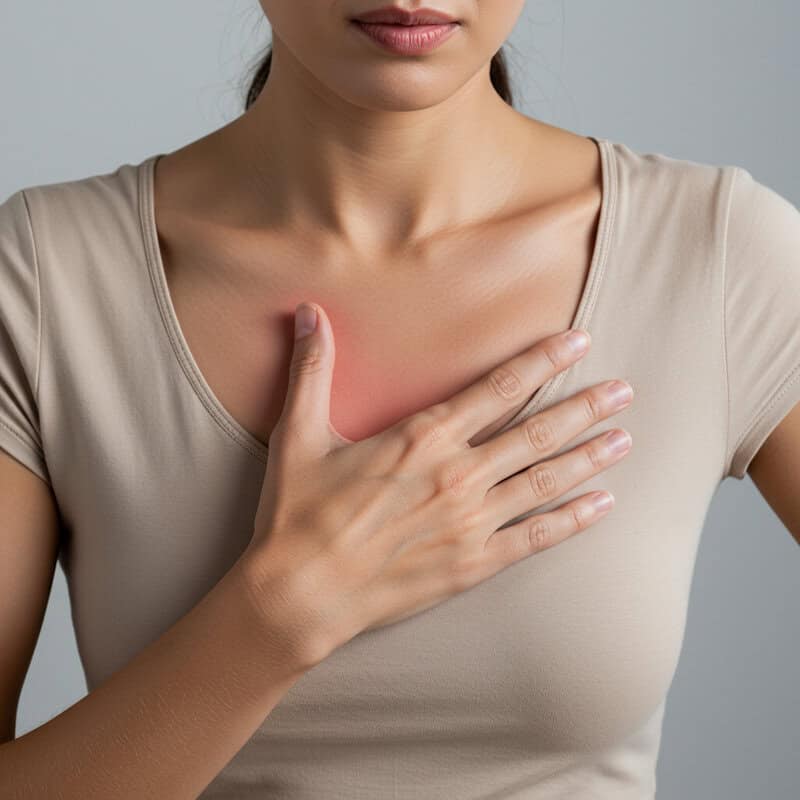
Persistent nipple pain is a symptom that can sometimes signal an underlying breast condition, including breast cancer. While temporary nipple discomfort is common due to friction from clothing, hormonal changes, or breastfeeding, pain that lasts for weeks or increases over time should not be ignored. Cancer-related nipple pain is often ongoing, may be sharp or burning, and typically affects only one nipple.
For example, you might notice a stinging or throbbing sensation that makes wearing certain fabrics uncomfortable, or persistent soreness that doesn’t improve with topical remedies or after your menstrual cycle. This type of pain might also be accompanied by other symptoms, such as redness, swelling, scaling, or discharge. Unlike irritation from new bras or exercise, cancer-related pain does not subside with lifestyle changes or rest.
If you experience ongoing nipple pain—especially when it is isolated to one side, does not respond to usual care, or is associated with other changes—consult your healthcare provider for a thorough evaluation. Early recognition is important for timely intervention. For more details about when nipple pain warrants medical attention, visit the American Cancer Society.
46. Breast Skin Sores
Breast skin sores are open lesions or wounds that develop on the surface of the breast and can be a sign of advanced breast cancer. Unlike minor skin irritations, rashes, or pimples—which typically heal quickly with basic care—cancer-related sores persist, may worsen over time, and can resist standard topical treatments. These sores often appear as raw, red, or ulcerated areas and may be accompanied by bleeding, oozing, or the formation of a scab that does not heal.
For example, a person might notice a sore that starts as a small, tender spot but enlarges and fails to improve despite cleansing and the use of antibiotic ointments. Unlike eczema or simple dermatitis, these lesions are more likely to be deep, painful, and surrounded by hardened or discolored skin. Such sores may also emit an unpleasant odor if infection sets in, further complicating the healing process.
The development of persistent or worsening skin sores on the breast is a medical emergency and requires prompt evaluation by a healthcare provider. Early intervention is crucial for effective treatment and to prevent further complications. For more information on breast cancer symptoms and when to seek help, visit the American Cancer Society.
47. Change in Breast Contour

Change in breast contour refers to a noticeable alteration in the natural shape or outline of the breast. This can manifest as dimpling, bulging, flattening, or irregularities along the breast’s edge, which may be subtle at first but become more pronounced over time. Such changes are often caused by underlying growths or tumors that pull on the surrounding tissue, altering the breast’s overall appearance.
For example, you might observe that the curve of one breast is no longer as smooth or symmetrical as it once was, or that there is a new indentation when you raise your arms or look in the mirror from different angles. A before-and-after comparison—such as noticing a previously rounded outline now showing a flat spot or an unusual bulge—can be helpful in identifying early signs of concern. These contour changes can be distinct from the normal, cyclical shifts that occur with hormonal fluctuations or weight changes, which are typically even and temporary.
Regular self-examination and visual checks in good lighting can help you detect any changes in breast shape or silhouette. If you notice persistent or unexplained changes in your breast contour, consult a healthcare provider for evaluation. Learn more at the American Cancer Society.
48. Breast Hardness in One Area
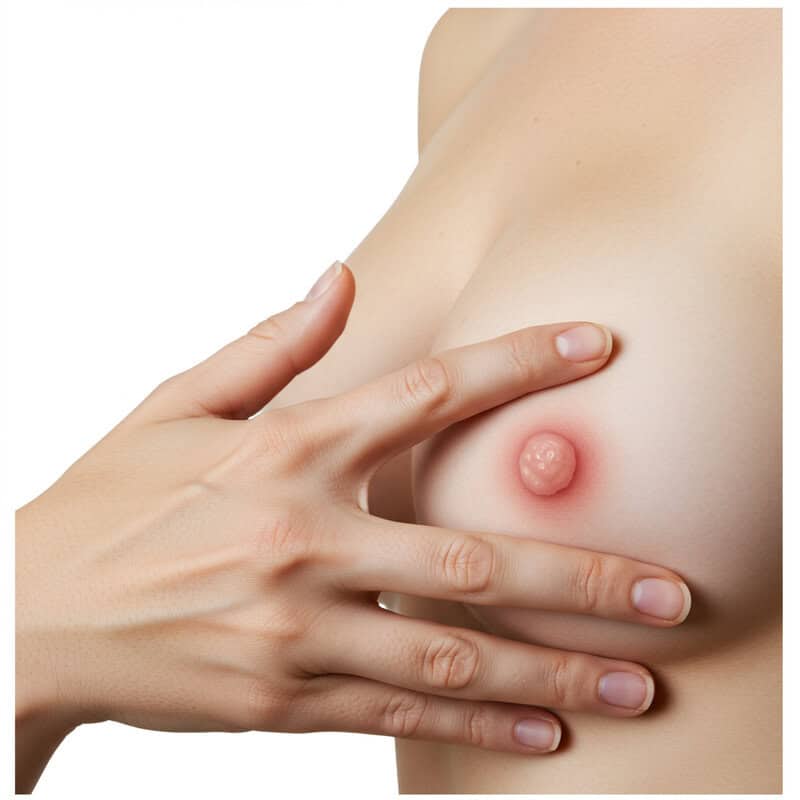
Breast hardness in one area is a symptom that can indicate the presence of a tumor or abnormal tissue growth. Normally, breast tissue is soft to the touch, though it can feel dense or slightly lumpy in some individuals, especially due to hormonal fluctuations. However, a new, persistent area that feels distinctly hard—almost like a rock or marble beneath the skin—should be taken seriously. This localized firmness is often different in texture from the surrounding normal breast tissue and does not change with the menstrual cycle.
For instance, you might notice a firm, immovable spot during a self-exam, or feel that one section of your breast is stiffer when compared to the rest. Unlike the generalized firmness that can be felt throughout the breast during certain times of the month, cancer-related hardness tends to be isolated and does not resolve over time. This area may or may not be painful, but its persistence is what makes it concerning.
If you detect a new, hard spot in your breast that does not go away or feels different from your usual tissue, monitor it closely and schedule an evaluation with your healthcare provider. Early assessment is key. For more information, visit the American Cancer Society.
49. Unexplained Breast Soreness
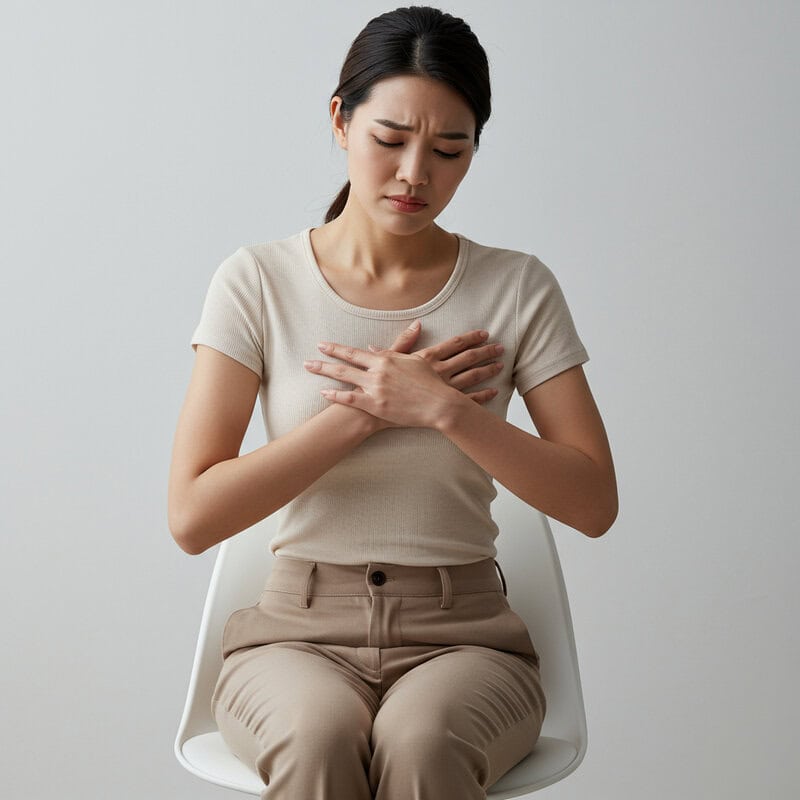
Unexplained breast soreness refers to discomfort or pain that arises without any obvious reason such as injury, intense physical activity, or hormonal changes. While it’s common to experience mild breast soreness after a strenuous workout or during certain phases of the menstrual cycle, this type of soreness is usually short-lived and can be clearly linked to a specific cause. In contrast, soreness associated with breast cancer often appears suddenly, persists for several days or weeks, and does not improve with rest or over-the-counter pain relievers.
For example, you might notice persistent tenderness when touching the breast, wearing a bra, or even at rest, despite no changes in your routine or physical activity. Unlike muscle-related soreness, which typically affects both breasts and fades with time, cancer-related soreness is more likely to be localized, affect only one breast, and may be accompanied by other symptoms such as swelling, a lump, or skin changes.
If you develop ongoing soreness in one or both breasts for no apparent reason, it’s important to monitor how long it lasts and whether it changes in intensity. Persistent or worsening soreness should be evaluated by a healthcare provider. For more information, visit the American Cancer Society.
50. Breast Changes After Menopause
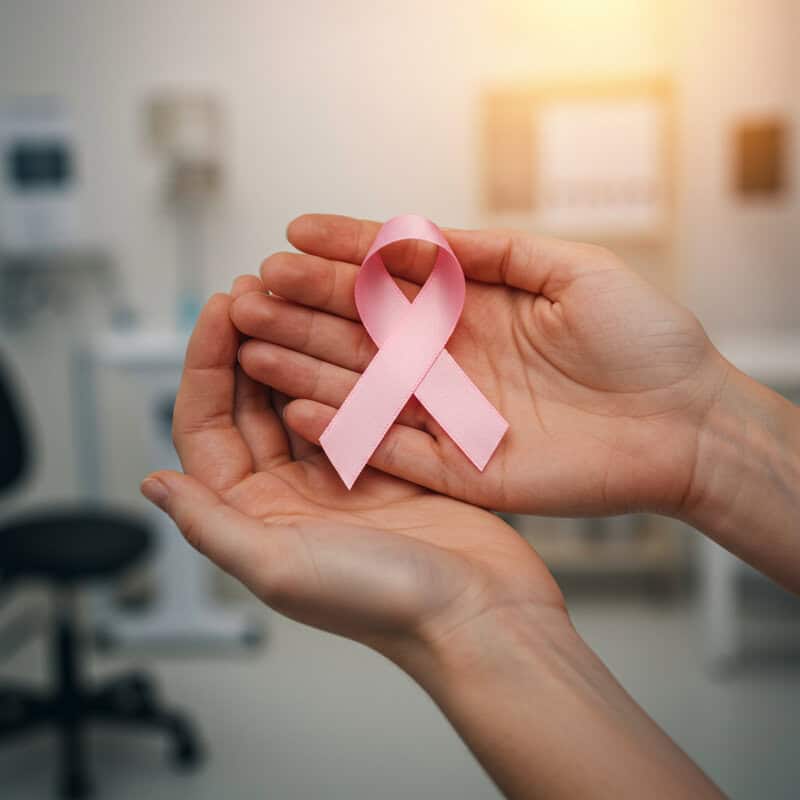
Breast changes after menopause are particularly concerning because hormonal fluctuations that typically cause benign breast symptoms during the reproductive years are significantly reduced or absent. After menopause, the breasts generally become less dense, less tender, and more stable in size and shape. Therefore, the development of new symptoms—such as lumps, swelling, nipple discharge, skin changes, or persistent pain—should be taken very seriously.
For example, a postmenopausal woman who notices a new lump, unexplained soreness, or any change in the shape or texture of one breast should not attribute these symptoms to normal hormonal cycles. Unlike premenopausal women, the likelihood that such symptoms are due to benign causes is lower, and the risk of breast cancer increases with age. Even small changes, such as subtle dimpling of the skin or a shift in nipple position, warrant prompt medical attention.
If you experience any new or unusual breast changes after menopause, it is crucial to report them to your healthcare provider immediately. Early evaluation and diagnosis are essential for the best possible outcomes. For more guidance on postmenopausal breast health, visit the American Cancer Society.
Conclusion
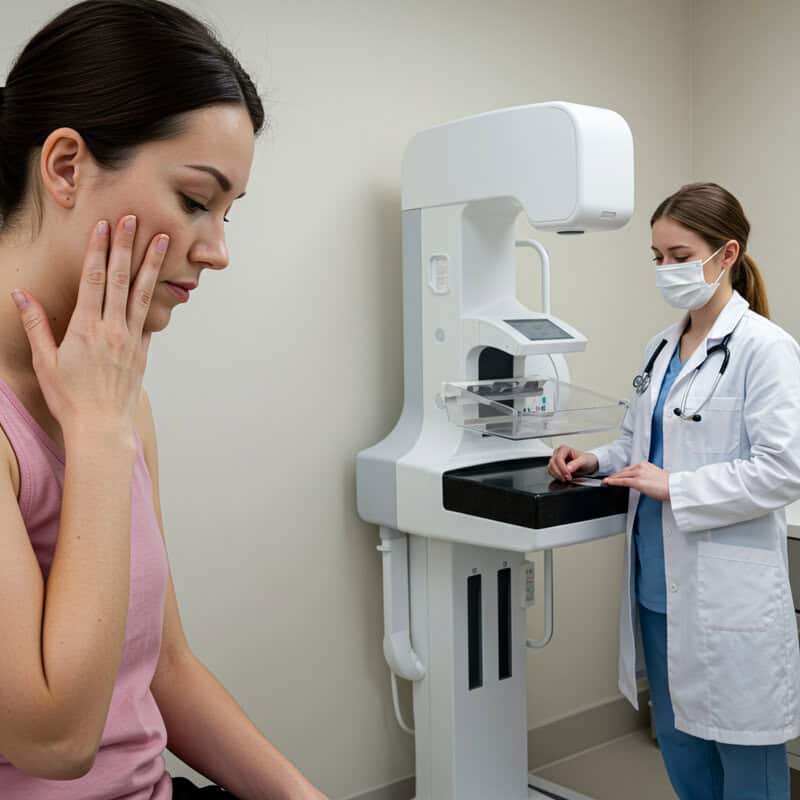
Recognizing the warning signs of breast cancer is vital for early detection and improving outcomes. If you notice any persistent or unusual changes in your breasts, don’t ignore them—promptly consult a healthcare provider. Proactive screening, including regular self-exams and mammograms, can make a significant difference. Remember, early intervention saves lives. If you have concerns or questions, schedule an appointment with your doctor or visit trusted resources like the American Cancer Society.
Disclaimer: This article is for informational purposes only and does not substitute for professional medical advice, diagnosis, or treatment. Always seek the guidance of your physician or other qualified health provider with any questions regarding a medical condition.
Disclaimer
The information provided in this article is for general informational purposes only. While we strive to keep the information up-to-date and correct, we make no representations or warranties of any kind, express or implied, about the completeness, accuracy, reliability, suitability, or availability with respect to the article or the information, products, services, or related graphics contained in the article for any purpose. Any reliance you place on such information is therefore strictly at your own risk.
In no event will we be liable for any loss or damage including without limitation, indirect or consequential loss or damage, or any loss or damage whatsoever arising from loss of data or profits arising out of, or in connection with, the use of this article.
Through this article you are able to link to other websites which are not under our control. We have no control over the nature, content, and availability of those sites. The inclusion of any links does not necessarily imply a recommendation or endorse the views expressed within them.
Every effort is made to keep the article up and running smoothly. However, we take no responsibility for, and will not be liable for, the article being temporarily unavailable due to technical issues beyond our control.





